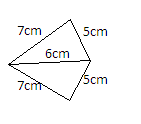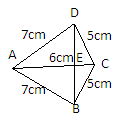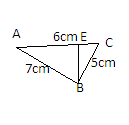
The lengths of four sides and a diagonal of the given quadrilateral are indicated in the diagram. If A denotes the area and l the length of the other diagonal, then A and l are respectively-

A.$12\sqrt 6 ,4\sqrt 6 $
B.$12\sqrt 6 ,5\sqrt 6 $
C.$6\sqrt 6 ,4\sqrt 6 $
D.$6\sqrt 6 ,5\sqrt 6 $

Answer
554.7k+ views
Hint: Let the quadrilateral be ABCD then the total area of the quadrilateral=area of triangle ABC+ area of triangle ACD. Since the sides of the triangle, ABC and ACD have the same measurement so they are congruent so they will have equal area. Find the area of the triangle using formula-
Area of triangle=$\sqrt {s\left( {s - a} \right)\left( {s - b} \right)\left( {s - c} \right)} $ Where a, b and c are sides of the triangle and s=$\dfrac{{a + b + c}}{2}$
Put all the values and solve it then find the area of the quadrilateral. Then consider the length of the other triangle to be l cm. Then chose a midpoint E such that BE=ED=$\dfrac{l}{2}$then use the formula-
Area of triangle ABC=$\dfrac{1}{2} \times b \times h$ where b=base and h=height. Put all the values in the formula and solve it to get the value of l.
Complete step-by-step answer:
Given, the quadrilateral ABCD has the following four sides- AB=AD=$7$ cm, BC=CD=$5$ cm, and AC=$6$ cm
We have to find the area of the quadrilateral and the length of the other diagonal BD. Let BD=l cm

From diagram, it is clear that the total area of the quadrilateral=area of triangle ABC+ area of triangle ACD
The diagonal AC divided the quadrilateral into two equal triangles as they have same measurement of sides and one common side so we can write-
Total area of the quadrilateral=area of triangle ABC+ area of triangle ABC=$2 \times $ Area of triangle ABC--(i)
Now we know that area of triangle=$\sqrt {s\left( {s - a} \right)\left( {s - b} \right)\left( {s - c} \right)} $ --- (ii)
Where a, b and c are sides of the triangle and s=$\dfrac{{a + b + c}}{2}$
So here a=$7$ cm, b=$5$ cm and c=$6$ cm then
$ \Rightarrow s = \dfrac{{7 + 5 + 6}}{2}$
On addition, we have-
$ \Rightarrow s = \dfrac{{18}}{2} = 9$
Now, on putting all the values in eq. (ii), we get-
$ \Rightarrow $ Area of triangle ABC=$\sqrt {9\left( {9 - 7} \right)\left( {9 - 6} \right)\left( {9 - 5} \right)} $
On solving, we get-
$ \Rightarrow $ Area of triangle ABC=$\sqrt {9 \times 2 \times 3 \times 4} $
On solving further we get-
$ \Rightarrow $ Area of triangle ABC=$6\sqrt 6 $
On putting this value in eq. (i), we get-
Total area of the quadrilateral= $2 \times 6\sqrt 6 $
On multiplication, we get-
The total area of the quadrilateral= $12\sqrt 6 $
Now Let E be the midpoint of BD such that BE=ED=$\dfrac{{BD}}{2}$
And since BD=$l$ then BE=ED=$\dfrac{l}{2}$

Now, we know that we can write the area of triangle ABC=$\dfrac{1}{2} \times AC \times BE$ as AC is the base and BE is the height of the triangle.
On putting the values, we get-
$ \Rightarrow 6\sqrt 6 = \dfrac{1}{2} \times 6 \times \dfrac{l}{2}$
On solving, we get-
$ \Rightarrow l = 2 \times 2\sqrt 6 = 4\sqrt 6 $ cm
The length of the other diagonal is $4\sqrt 6 $ cm
The correct answer is option A.
Note: Here we can separately solve for the area of triangle ACD using the provided formula and then add it to the area of triangle ABC. Also, we can also use triangle ACD to find the length of the other triangle by following the same process as we have done in the above solution.
Area of triangle=$\sqrt {s\left( {s - a} \right)\left( {s - b} \right)\left( {s - c} \right)} $ Where a, b and c are sides of the triangle and s=$\dfrac{{a + b + c}}{2}$
Put all the values and solve it then find the area of the quadrilateral. Then consider the length of the other triangle to be l cm. Then chose a midpoint E such that BE=ED=$\dfrac{l}{2}$then use the formula-
Area of triangle ABC=$\dfrac{1}{2} \times b \times h$ where b=base and h=height. Put all the values in the formula and solve it to get the value of l.
Complete step-by-step answer:
Given, the quadrilateral ABCD has the following four sides- AB=AD=$7$ cm, BC=CD=$5$ cm, and AC=$6$ cm
We have to find the area of the quadrilateral and the length of the other diagonal BD. Let BD=l cm

From diagram, it is clear that the total area of the quadrilateral=area of triangle ABC+ area of triangle ACD
The diagonal AC divided the quadrilateral into two equal triangles as they have same measurement of sides and one common side so we can write-
Total area of the quadrilateral=area of triangle ABC+ area of triangle ABC=$2 \times $ Area of triangle ABC--(i)
Now we know that area of triangle=$\sqrt {s\left( {s - a} \right)\left( {s - b} \right)\left( {s - c} \right)} $ --- (ii)
Where a, b and c are sides of the triangle and s=$\dfrac{{a + b + c}}{2}$
So here a=$7$ cm, b=$5$ cm and c=$6$ cm then
$ \Rightarrow s = \dfrac{{7 + 5 + 6}}{2}$
On addition, we have-
$ \Rightarrow s = \dfrac{{18}}{2} = 9$
Now, on putting all the values in eq. (ii), we get-
$ \Rightarrow $ Area of triangle ABC=$\sqrt {9\left( {9 - 7} \right)\left( {9 - 6} \right)\left( {9 - 5} \right)} $
On solving, we get-
$ \Rightarrow $ Area of triangle ABC=$\sqrt {9 \times 2 \times 3 \times 4} $
On solving further we get-
$ \Rightarrow $ Area of triangle ABC=$6\sqrt 6 $
On putting this value in eq. (i), we get-
Total area of the quadrilateral= $2 \times 6\sqrt 6 $
On multiplication, we get-
The total area of the quadrilateral= $12\sqrt 6 $
Now Let E be the midpoint of BD such that BE=ED=$\dfrac{{BD}}{2}$
And since BD=$l$ then BE=ED=$\dfrac{l}{2}$

Now, we know that we can write the area of triangle ABC=$\dfrac{1}{2} \times AC \times BE$ as AC is the base and BE is the height of the triangle.
On putting the values, we get-
$ \Rightarrow 6\sqrt 6 = \dfrac{1}{2} \times 6 \times \dfrac{l}{2}$
On solving, we get-
$ \Rightarrow l = 2 \times 2\sqrt 6 = 4\sqrt 6 $ cm
The length of the other diagonal is $4\sqrt 6 $ cm
The correct answer is option A.
Note: Here we can separately solve for the area of triangle ACD using the provided formula and then add it to the area of triangle ABC. Also, we can also use triangle ACD to find the length of the other triangle by following the same process as we have done in the above solution.
Recently Updated Pages
Master Class 8 Social Science: Engaging Questions & Answers for Success

Master Class 8 Maths: Engaging Questions & Answers for Success

Master Class 8 Science: Engaging Questions & Answers for Success

Class 8 Question and Answer - Your Ultimate Solutions Guide

Master Class 8 English: Engaging Questions & Answers for Success

Master Class 6 English: Engaging Questions & Answers for Success

Trending doubts
What is BLO What is the full form of BLO class 8 social science CBSE

Which one of the following groups comprises states class 8 social science CBSE

Citizens of India can vote at the age of A 18 years class 8 social science CBSE

Full form of STD, ISD and PCO

A couple went for a picnic They have 5 sons and each class 8 maths CBSE

Right to vote is a AFundamental Right BFundamental class 8 social science CBSE





